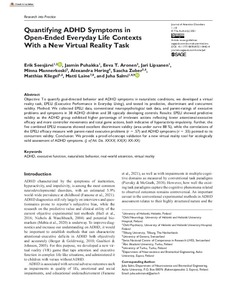| dc.contributor.author | Mannerkoski Minna | |
| dc.contributor.author | Seesjärvi Erik | |
| dc.contributor.author | Lipsanen Jari | |
| dc.contributor.author | Zuber Sascha | |
| dc.contributor.author | Laine Matti | |
| dc.contributor.author | Aronen Eeva T. | |
| dc.contributor.author | Kliegel Matthias | |
| dc.contributor.author | Salmi Juha | |
| dc.contributor.author | Puhakka Jasmin | |
| dc.contributor.author | Hering Alexandra | |
| dc.date.accessioned | 2022-10-27T12:08:52Z | |
| dc.date.available | 2022-10-27T12:08:52Z | |
| dc.identifier.uri | https://www.utupub.fi/handle/10024/156597 | |
| dc.description.abstract | <p>Objective: To quantify goal-directed behavior and ADHD symptoms in naturalistic conditions, we developed a virtual reality task, EPELI (Executive Performance in Everyday LIving), and tested its predictive, discriminant and concurrent validity. <br></p><p>Method: We collected EPELI data, conventional neuropsychological task data, and parent-ratings of executive problems and symptoms in 38 ADHD children and 38 typically developing controls. <br></p><p>Results: EPELI showed predictive validity as the ADHD group exhibited higher percentage of irrelevant actions reflecting lower attentional-executive efficacy and more controller movements and total game actions, both indicative of hyperactivity-impulsivity. Further, the five combined EPELI measures showed excellent discriminant validity (area under curve 88 %), while the correlations of the EPELI efficacy measure with parent-rated executive problems (r = .57) and ADHD symptoms (r = .55) pointed to its concurrent validity.<br></p><p> Conclusion: We provide a proof-of-concept validation for a new virtual reality tool for ecologically valid assessment of ADHD symptoms.<br></p> | |
| dc.language.iso | en | |
| dc.publisher | Sage | |
| dc.title | Quantifying ADHD Symptoms in Open-Ended Everyday Life Contexts With a New Virtual Reality Task | |
| dc.identifier.url | https://doi.org/10.1177/10870547211044214 | |
| dc.identifier.urn | URN:NBN:fi-fe2022012811229 | |
| dc.contributor.organization | fi=psykologia|en=Psychology| | |
| dc.contributor.organization-code | 2603103 | |
| dc.converis.publication-id | 68488537 | |
| dc.converis.url | https://research.utu.fi/converis/portal/Publication/68488537 | |
| dc.identifier.eissn | 1557-1246 | |
| dc.identifier.jour-issn | 1087-0547 | |
| dc.okm.affiliatedauthor | Laine, Matti | |
| dc.okm.discipline | 3124 Neurology and psychiatry | en_GB |
| dc.okm.discipline | 3124 Neurologia ja psykiatria | fi_FI |
| dc.okm.discipline | 515 Psychology | en_GB |
| dc.okm.discipline | 515 Psykologia | fi_FI |
| dc.okm.internationalcopublication | international co-publication | |
| dc.okm.internationality | International publication | |
| dc.okm.type | Journal article | |
| dc.publisher.country | Yhdysvallat (USA) | fi_FI |
| dc.publisher.country | United States | en_GB |
| dc.publisher.country-code | US | |
| dc.relation.articlenumber | 10870547211044214 | |
| dc.relation.doi | 10.1177/10870547211044214 | |
| dc.relation.ispartofjournal | Journal of Attention Disorders | |
| dc.year.issued | 2021 | |
